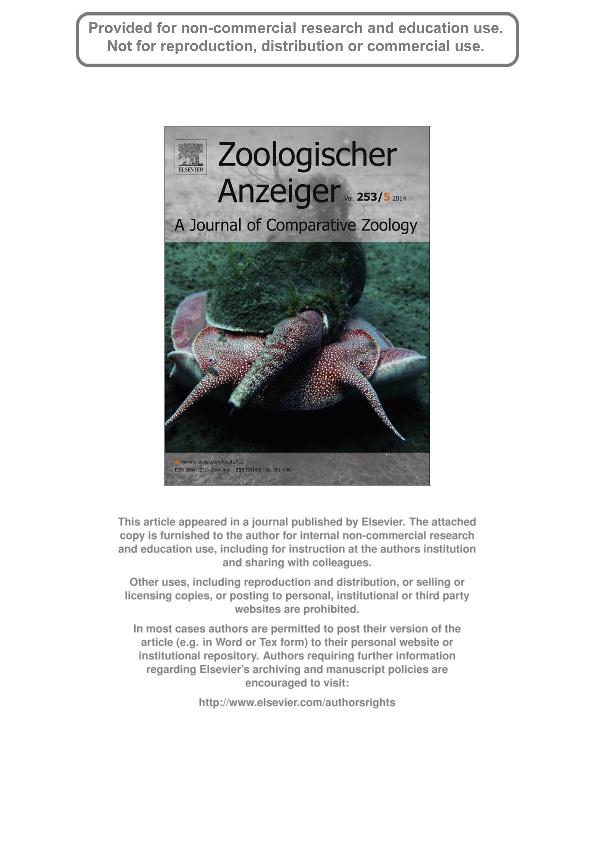Mostrar el registro sencillo del ítem
dc.contributor.author
Bigatti, Gregorio

dc.contributor.author
Giraud Billoud, Maximiliano German

dc.contributor.author
Vega, Israel Aníbal

dc.contributor.author
Penchaszadeh, Pablo Enrique

dc.contributor.author
Castro Vazquez, Alfredo Juan

dc.date.available
2016-12-28T14:16:24Z
dc.date.issued
2014-06
dc.identifier.citation
Bigatti, Gregorio; Giraud Billoud, Maximiliano German; Vega, Israel Aníbal; Penchaszadeh, Pablo Enrique; Castro Vazquez, Alfredo Juan; Embryonic development in the Patagonian red snail Odontocymbiola magellanica (Neogastropoda: Volutidae): morphology and biochemistry; Elsevier Gmbh; Zoologischer Anzeiger; 253; 5; 6-2014; 372-381
dc.identifier.issn
0044-5231
dc.identifier.uri
http://hdl.handle.net/11336/10402
dc.description.abstract
Embryo morphology, feeding mechanism and changes in composition of the egg capsule content during development (intracapsular fluids and embryos) were studied in Odontocymbiola magellanica from newly spawned egg capsules to the pre-hatching juvenile stage. Changes in embryo morphology and behavior are presented, based on observations and micrographs of living specimens and scanning electron microscopy. The arrangement of velar cilia and athrocytes and shell gland location and development differed markedly from other studied caenogastropods. Embryo ingestion of intracapsular fluid was promoted by velar ciliary currents at least from the early veliger stage, while feeding by grazing on the inner membranous layer of the egg capsule was rarely observed until juveniles were about to hatch. The main growth of embryos occurred during the veliger stages. A significant nutritional investment in egg capsules, as compared with other South American volutids was observed. Nutrition from proteins seemed to predominate at the expense of a high molecular weight fraction (>220 kDa). Calcium concentration in the intracapsular fluid remained constant during development, but notably, the total intracapsular content (i.e., the amount contained in both fluid and embryos) increased 3-fold, which may be explained by extraction from the egg capsule magnesium-rich calcite cover, or alternatively, by uptake of calcium from the surrounding sea water. Ammonia, a major end-product of nitrogen metabolism in marine invertebrates, was present in both embryos and intracapsular fluid, from which it may easily diffuse to the surrounding sea water through the egg capsule wall. Our results on embryo morphology, development and biochemical changes provide useful comparative data for evolutionary and developmental studies in the Volutidae as well as in other caenogastropods.
dc.format
application/pdf
dc.language.iso
eng
dc.publisher
Elsevier Gmbh

dc.rights
info:eu-repo/semantics/openAccess
dc.rights.uri
https://creativecommons.org/licenses/by-nc-nd/2.5/ar/
dc.subject
Caenogastropoda
dc.subject
Athrocytes
dc.subject
Developmental Traits
dc.subject
Egg-Capsules
dc.subject
Embryo Nutrition
dc.subject.classification
Biología del Desarrollo

dc.subject.classification
Ciencias Biológicas

dc.subject.classification
CIENCIAS NATURALES Y EXACTAS

dc.title
Embryonic development in the Patagonian red snail Odontocymbiola magellanica (Neogastropoda: Volutidae): morphology and biochemistry
dc.type
info:eu-repo/semantics/article
dc.type
info:ar-repo/semantics/artículo
dc.type
info:eu-repo/semantics/publishedVersion
dc.date.updated
2016-11-23T19:42:33Z
dc.journal.volume
253
dc.journal.number
5
dc.journal.pagination
372-381
dc.journal.pais
Alemania

dc.journal.ciudad
Berlin
dc.description.fil
Fil: Bigatti, Gregorio. Consejo Nacional de Investigaciones Científicas y Técnicas. Centro Nacional Patagónico; Argentina
dc.description.fil
Fil: Giraud Billoud, Maximiliano German. Consejo Nacional de Investigaciones Cientiíâficas y Tecnicas. Centro Cientifico Tecnologico Mendoza. Instituto Histologia y Embriologia de Mendoza "dr. M. Burgos"; Argentina. Universidad Nacional de Cuyo. Facultad de Ciencias Médicas. Instituto de Fisiología; Argentina
dc.description.fil
Fil: Vega, Israel Aníbal. Consejo Nacional de Investigaciones Cientiíâficas y Tecnicas. Centro Cientifico Tecnologico Mendoza. Instituto Histologia y Embriologia de Mendoza "dr. M. Burgos"; Argentina
dc.description.fil
Fil: Penchaszadeh, Pablo Enrique. Consejo Nacional de Investigaciones Científicas y Técnicas. Oficina de Coordinación Administrativa Parque Centenario. Museo Argentino de Ciencias Naturales; Argentina
dc.description.fil
Fil: Castro Vazquez, Alfredo Juan. Consejo Nacional de Investigaciones Científicas y Tecnicas. Centro Cientifico Tecnologico Mendoza. Instituto Histologia y Embriologia de Mendoza "Dr. M. Burgos"; Argentina
dc.journal.title
Zoologischer Anzeiger

dc.relation.alternativeid
info:eu-repo/semantics/altIdentifier/url/http://www.sciencedirect.com/science/article/pii/S0044523114000199
dc.relation.alternativeid
info:eu-repo/semantics/altIdentifier/doi/http://dx.doi.org/10.1016/j.jcz.2014.03.001
Archivos asociados
